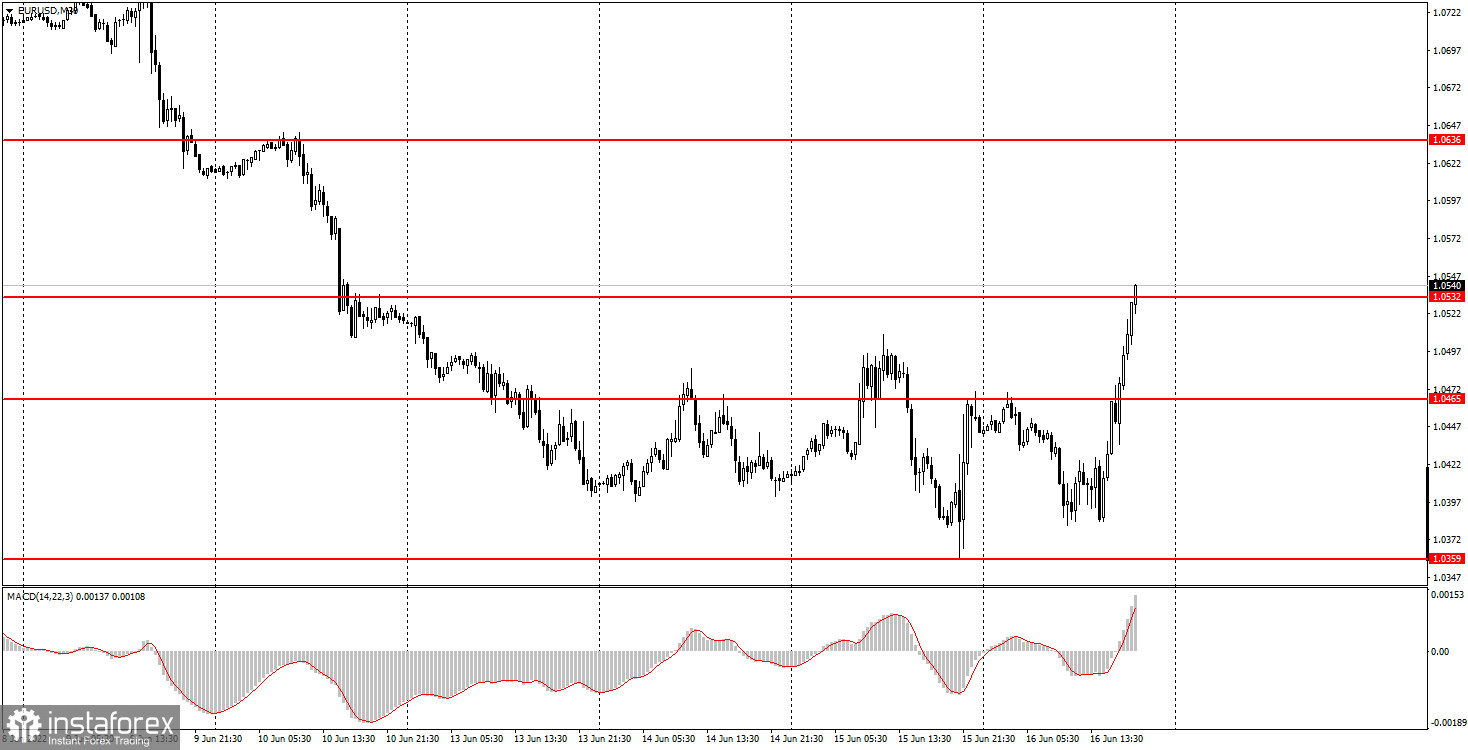Analysis of Thursday's deals:
30M chart of the EUR/USD pair

The EUR/USD currency pair traded on Thursday as we predicted the day before. That is, it is difficult to predict, and also very volatile. Recall that the calendars of events in the US and the EU were completely empty on Thursday, that is, traders had nothing to react to during the day. However, at the moment the pair has already passed about 180 points from the low to the high of the day. This is a lot for the euro. Does anyone doubt that the reasons lie in the plane of the Federal Reserve, which raised the rate by 0.75% last night? And even despite the fact that the movement should have been reversed (that is, the dollar should have grown, not the euro), we still believe that the reason for such a strong movement on Thursday was the outcome of the Fed meeting. We have already talked about the pair's illogical movement both last night and today. Firstly, the market does not always work out important events in the way it would be logical. Secondly, the euro has fallen very strongly (that is, the dollar has grown) during the last 5-6 trading days, so any increase in the Fed's rate could already have been a worked out by the market in advance. One way or another, we always warn that on the days of summing up the results of the meetings of the central banks, as well as on the days following them, the pair can be traded very volatile and difficult to predict.
5M chart of the EUR/USD pair

The technical picture looks very bad on the 5-minute timeframe, as the price ignored almost all the levels that it met on its way. This is also one of the disadvantages of those days when the fundamental background is very strong. Today, the pair managed to slide down, and traded in a flat, and showed the strongest growth. Quotes "danced" around the level of 1.0400 during the European trading session. The problem is not in the level itself, but again in the fundamental background. The first two signals, which turned out to be false, should have been enough to no longer trade near this level. The next signal available for processing was formed when the price rebounded from the level of 1.0465. But this signal turned out to be false. It still managed to set Stop Loss to breakeven. The next signal was the only one that allowed traders to earn. The price overcame the level of 1.0465 and after that went up 80 points. That's how much newcomers could earn. Total: the loss is about 40 points on the first two transactions, while the profit is 80 points on the last transaction.
How to trade on Friday:
The pair began a powerful upward movement on the 30-minute timeframe, which was almost impossible to predict. However, the pair has taken a tangible step towards a new upward trend. There is no trend line or channel at the moment, as the movement has just begun. The most important events of the month have been left behind, so the pair's succeeding movements should be more calm. On the 5-minute TF, it is recommended to trade at the levels of 1.0465, 1.0532, 1.0564, 1.0607, 1.0636, 1.0663, 1.0697. When passing 15 points in the right direction, you should set Stop Loss to breakeven. The European Union will publish the final value of inflation for May. The first estimate is 8.1%. It is unlikely that the second assessment will be very different from the first. Meanwhile, Fed Chairman Jerome Powell will deliver a speech, which is always important, as well as an insignificant report on industrial production.
Basic rules of the trading system:
1) The signal strength is calculated by the time it took to form the signal (bounce or overcome the level). The less time it took, the stronger the signal.
2) If two or more deals were opened near a certain level based on false signals (which did not trigger Take Profit or the nearest target level), then all subsequent signals from this level should be ignored.
3) In a flat, any pair can form a lot of false signals or not form them at all. But in any case, at the first signs of a flat, it is better to stop trading.
4) Trade deals are opened in the time period between the beginning of the European session and until the middle of the American one, when all deals must be closed manually.
5) On the 30-minute TF, using signals from the MACD indicator, you can trade only if there is good volatility and a trend, which is confirmed by a trend line or a trend channel.
6) If two levels are located too close to each other (from 5 to 15 points), then they should be considered as an area of support or resistance.
On the chart:
Support and Resistance Levels are the Levels that serve as targets when buying or selling the pair. You can place Take Profit near these levels.
Red lines are the channels or trend lines that display the current trend and show in which direction it is better to trade now.
The MACD indicator (14,22,3) consists of a histogram and a signal line. When they cross, this is a signal to enter the market. It is recommended to use this indicator in combination with trend lines (channels and trend lines).
Important speeches and reports (always contained in the news calendar) can greatly influence the movement of a currency pair.
Therefore, during their exit, it is recommended to trade as carefully as possible or exit the market in order to avoid a sharp price reversal against the previous movement.
Beginners on Forex should remember that not every single trade has to be profitable. The development of a clear strategy and money management are the key to success in trading over a long period of time.





















